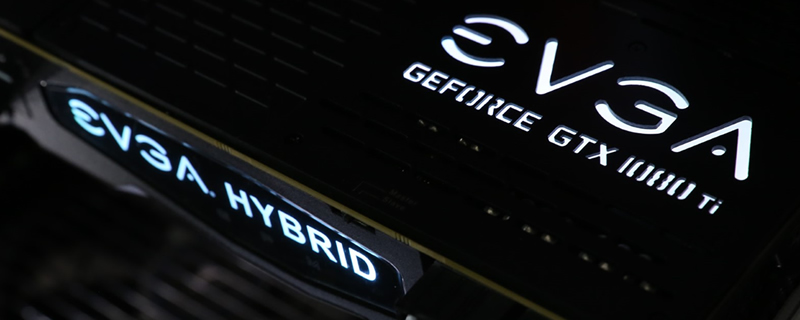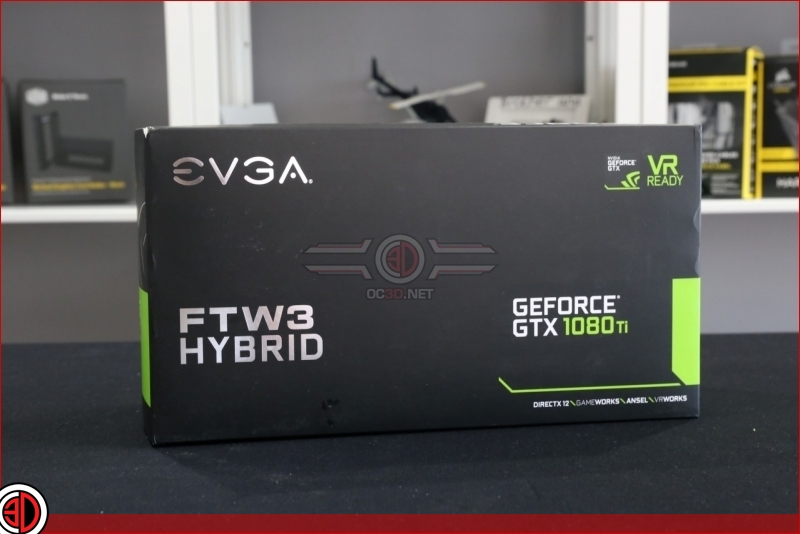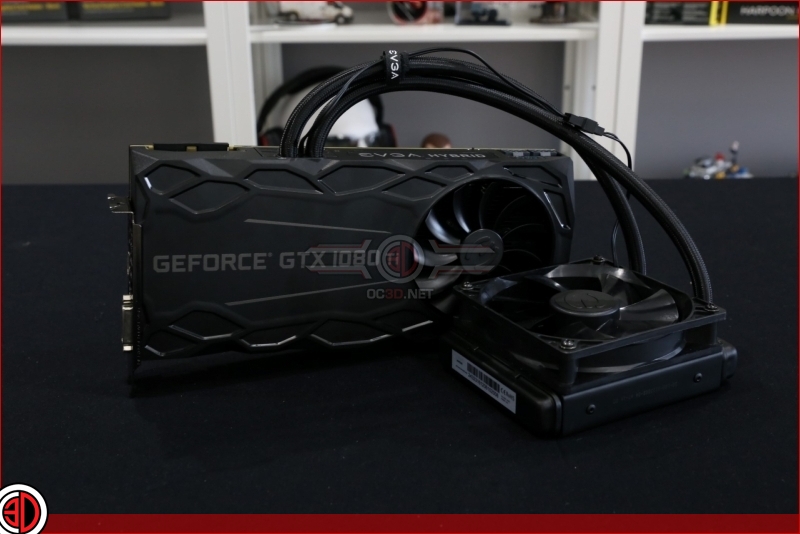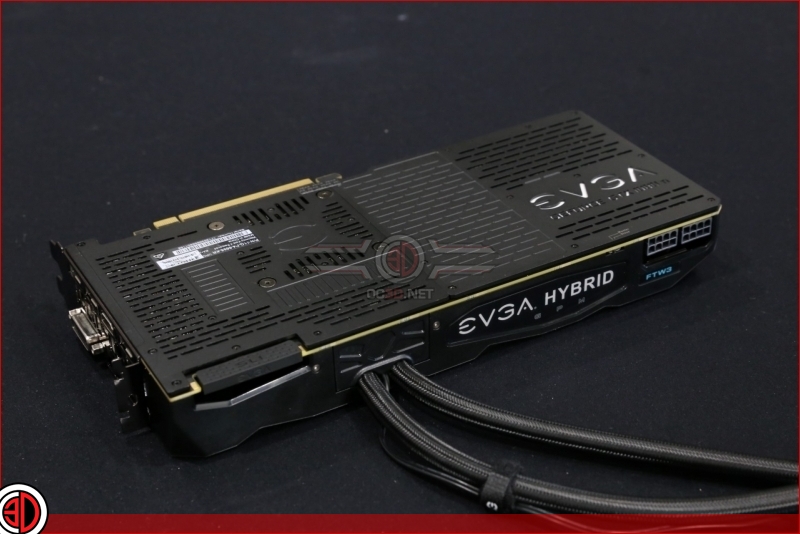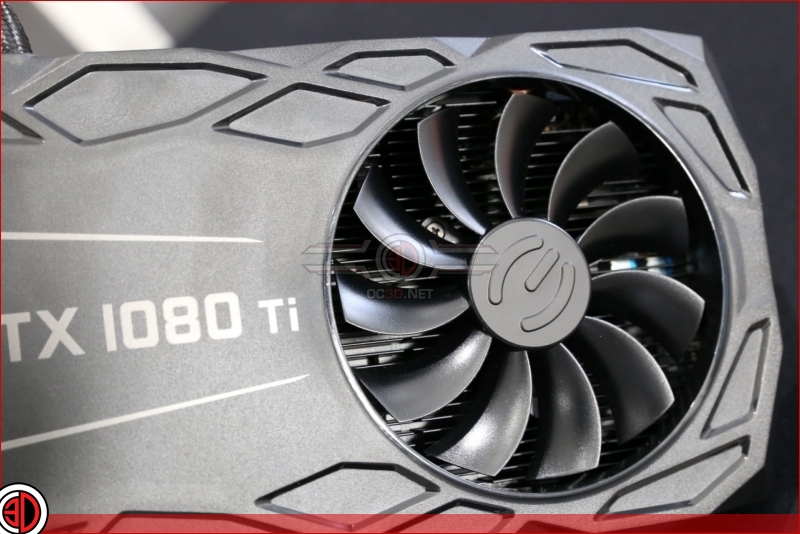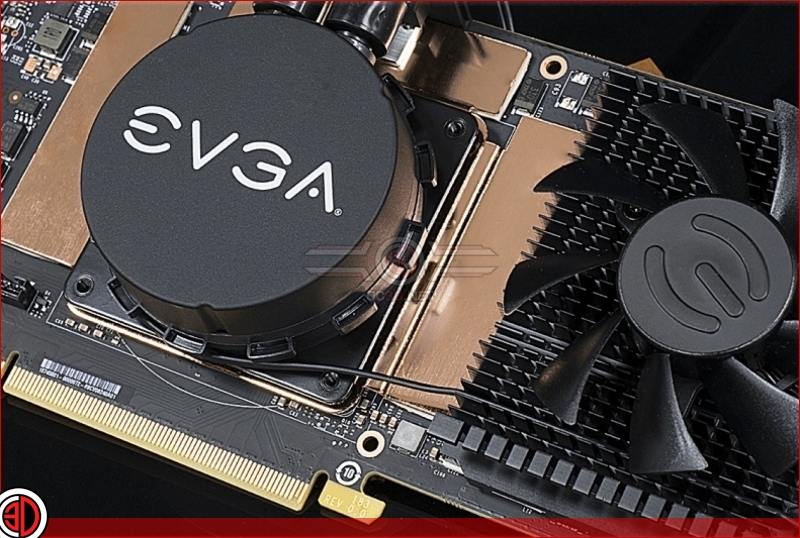EVGA GTX 1080 Ti FTW3 Hybrid – RushKit
EVGA GTX 1080 Ti FTW3 Hybrid – RushKit
 Â
Â
Looking at the packaging for EVGA’s GTX 1080 Ti FTW3 Hybrid we can see that it is using pretty standard Nvidia-style packaging, though the box is understandably thicker to accommodate this GPU and its radiator.Â
The GPU will ship with a driver CD, some EVGA branded stickers, a large EVGA poster (Folded 🙁 ), warranty information, a cable management kit (Velcro ties and cable ties) and a single 2x 6-pin to 8-pin PSU adapter.
We wouldn’t advise using this, as any reasonably modern PSU should already have an 8-pin PCIe power cable already. Â Â
Â
The GPU itself comes with a dark aesthetic, similar to EVGA’s current generation of “Black” series GPUs, making this GPU ideal for a stealth themed build if you can turn of this GPU’s LEDs in software.Â
Moving around to the backplate we can also see that it offers a large amount of surface area, making it ideal to cool this GPU passively from the rear. This backplate is connected to this GPU’s memory and VRM areas, offering additional cooling.Â
When looking at the specifications of this GPU we can see that the EVGA GTX 1080 Ti FTW3 Hybrid offers improved specifications over Nvidia’s Founders Edition model in almost every regard with more power phases, a higher maximum power draw and extra redundancy with a second BIOS chip.Â
When compared to the standard GT 1080 Ti FTW3 Gaming model we can see no listed clock speed improvements, though Nvidia’s Boost clock technology will likely take the GTX 1080 Ti to higher actual boost clock levels thanks to its lower operating temperatures.Â
Â
| Â | Nvidia GTX 1080 Ti FE | EVGA GTX 1080 Ti SC2 | EVGA GTX 1080 Ti FTW 3 Gaming | EVGA GTX 1080 Ti FTW3 Hybrid |
| GPU | GP102 | GP102 | GP102 | GP102 |
| CUDA Cores | 3584 | 3584 | 3584 | 3584 |
| Base Clock Speed | 1480MHz | 1556MHz | 1569MHz | 1569MHz |
| Boost Clock Speed | 1582MHz | 1670MHz | 1683MHz | 1683MHz |
| VRAM | 11GB | 11GB | 11GB | 11GB |
| Cooling | Air Reference | Air iCX | Air iCX | Hybrid |
| VRM | 7+2 | 7+2 | 10+2 | 10+2 |
| Power | 8+6 pin | 8+6-pin | 8+8 Pin | 8+8 Pin |
| Max Power Draw | 250W | 250W | 280W | 280W |
| BIOS Chips | 1 | 1 | 2 | 2 |
| RGB? | No | Yes | Yes | Yes |
Â
Â
When looking at EVGA’s hybrid cooling design we can see that the company has taken things very seriously, with a huge cooler under the GPUs integrated fan sitting over a large VRM heatsink which features a huge surface area. We also know that EVGA has found a way to connect their VRAM chip coolers to the AIO cooler itself, offering itÂ
We also know that EVGA has found a way to connect their VRAM chip coolers to the AIO cooler itself, letting the copper plate be cooled by the AIO, passively with airflow from the GPUs fan and from the rear with EVGA’s backplate. EVGA says that this solution will keep this GPU’s memory cooler than standard air cooler designs.Â
Below is an image which showcases EVGA’s Hybrid cooler design, this is not from the GTX 1080 Ti FTW3 Hybrid, but it is very similar. We have not taken apart our review sample to take a picture ourselves as we have only started conducting performance testing on this GPU.Â
 Â
Â
ConclusionÂ
Even with this brief encounter with EVGA’s GTX 1080 Ti FTW3 we can see that EVGA engineering teams are taking GPU cooling seriously, offering one of the most robust hybrid GPU cooling solutions that we have ever seen on the market. Â
While some consumers may like to see some more surface area/fins on the GPU’s VRAM coolers, it is clear that EVGA’s solution is more than capable of cooling the GTX 1080 Ti’s 11GB of VRAM. The integration of the AIO liquid cooler into the VRAM cooler design is very innovative and the additional cooling provided by the backplate should ensure that this cooler experiences no issues.
Moving on from that then there is the VRM cooler on this CPU, which sits directly under this GPU’s fan and offers a tonne of surface area, ensuring that the provided fan will not need to run very fast in order to keep this GPU’s VRMs in check. EVGA has certainly upped their VRM cooling game.Â
What EVGA is offering here is straight forward, a hybrid cooled GTX 1080 Ti that promises cooler operating temperatures and quieter operation than most standard air-cooled GPUs under load. This GPU will also be using EVGA’s custom PCB design, which features more power phases and an increased maximum power limit and higher base/boost clock speeds than Nvidia’s Founders Edition GTX 1080 Ti. Â
Over the next week or so we will be putting this GPU through its paces, so expect a review for this graphics card in the near future. We are also working on reviews for several X399 motherboards as well as some other products, so please come back to OC3D how well some of today’s latest hardware releases perform. Â Â
Â
You can join the discussion on EVGA’s GTX 1080 Ti FTW3 Hybrid GPU on the OC3D Forums.Â
Â



